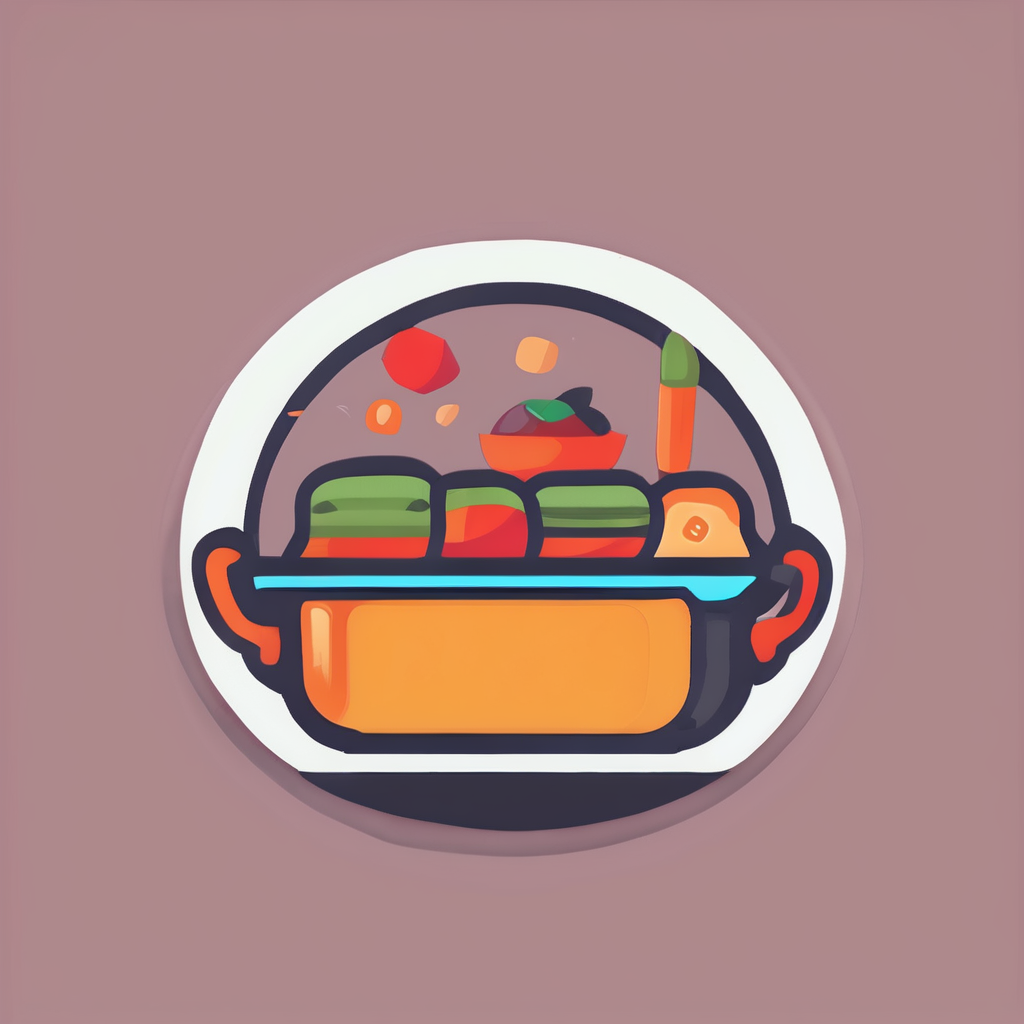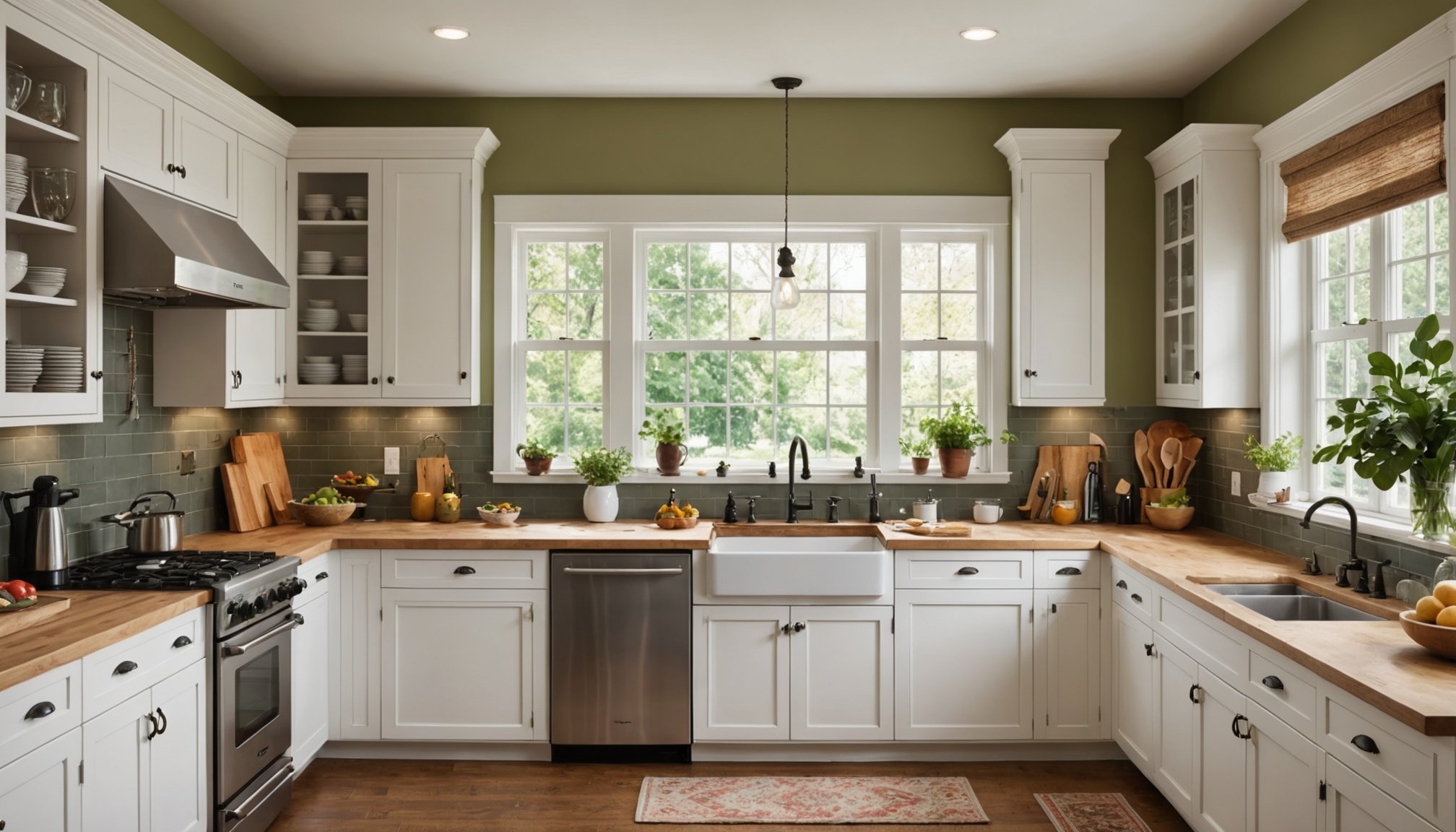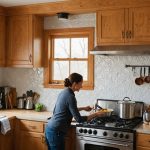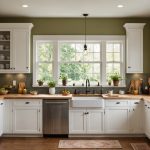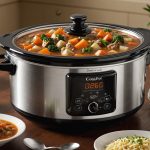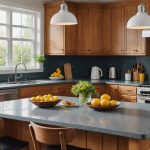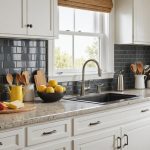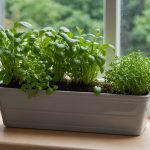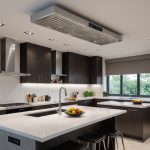Designing Your Kitchen Workspace
Creating an efficient kitchen layout is fundamental to enhancing both the functionality and enjoyment of your home culinary workspace. The significance of this extends particularly to both extensive and compact kitchens, where optimizing your kitchen layout becomes crucial. For those working in smaller spaces, it’s essential to arrange your culinary workspace creatively. Consider implementing space-saving solutions, such as adjustable shelving and pull-out countertops, to maximise available room while keeping the kitchen orderly.
To streamline workflow, allocate designated areas for specific culinary tasks. For instance, set up defined zones for preparation, cooking, and serving. This separation not only improves workflow efficiency but also keeps your culinary tools within easy reach. When planning your home culinary workspace, think about integrating multi-functional furniture or modular designs, offering flexibility and adaptability to changing needs.
Also read : Create an easy-care kitchen: smart strategies for stress-free cleaning and maintenance
Enhancing the functionality of a kitchen layout also involves considering lighting and ergonomic arrangements. Utilize ample natural light where possible, and install adjustable lighting to enhance visibility in work zones. Ergonomically, position frequently used items at an accessible height and distance, reducing strain and promoting productivity. Addressing these elements will elevate your workspace design, ensuring a space that is not only practical but delightful to work in.
Essential Equipment for Your Kitchen Oasis
In crafting your ideal kitchen oasis, selecting the right kitchen appliances and culinary tools is crucial. Prioritize essential equipment that aligns with your cooking style. For a home-based culinary business, appliances like a high-quality oven, efficient mixer, and versatile food processor become indispensable. These are the cornerstones upon which your culinary creations will flourish.
Also to discover : Window sill wonders: your ultimate guide to growing a thriving herb garden in miniature greens
Equally important are your must-have cooking tools and utensils. A chef’s knife, sturdy pans, and measuring cups provide a solid foundation for any culinary task. Investing in versatile and multi-functional equipment can greatly enhance your cooking efficiency. Consider tools that can perform multiple functions, such as an immersion blender that doubles as a whisk.
While stocking your kitchen, it’s beneficial to think about versatility. Items that allow flexibility not only save space but also cater to an array of culinary needs. This adaptability ensures your kitchen remains equipped to handle a variety of dishes and cooking techniques. In doing so, you create a functional and inspiring culinary environment that encourages culinary exploration while optimising space and resources.
Storage Solutions for Every Kitchen
Optimizing kitchen storage is essential for maintaining a clutter-free environment. Employing space-saving solutions can significantly enhance your organization efforts, particularly in smaller kitchens. One effective method is using innovative storage solutions such as adjustable shelves or roll-out drawers. These allow easy access to items stored at the back.
In addition, maximizing vertical space is an excellent strategy. Install high storage units or hang pots and pans to free up cupboard space. Utilize under-utilized areas like the top of cabinets for infrequently used items. Hooks and wall-mounted racks can also be employed for storing cooking tools within easy reach but out of the way.
For organizing kitchen ingredients and tools, consider clear containers or labelled jars, which help visually manage inventory and ensure that everything has its place. Creating a system for pantry staples and everyday items reduces search time and maintains order.
Incorporating these space-saving solutions and organizational techniques transforms your kitchen into an efficient, and visually pleasing space, irrespective of its size. By doing so, you enhance both functionality and the overall aesthetic appeal of your cooking area.
Aesthetic Inspiration and Design Elements
Sprucing up your kitchen aesthetics can transform your home culinary haven into an inspirational space. Start by selecting a color palette that kindles creativity and complements your kitchen’s functionality. Bright and warm tones like orange and yellow can invigorate, while softer hues such as pastel blues provide a calming backdrop.
Incorporating your personal style creates a distinctive atmosphere. Whether you’re drawn to sleek modernity or rustic flair, ensure your choices resonate with your culinary habits. For instance, minimalist enthusiasts might opt for streamlined designs with clean lines. Conversely, those preferring a homely vibe might embrace wooden textures and vintage accents.
Design inspiration can also bloom from varied visual stimuli. Gather ideas by exploring home décor magazines, online platforms, or industry showcases. These resources often feature curated examples of successful kitchen aesthetics. Displaying these examples can help inform your decisions, ensuring your kitchen’s design not only looks stunning but serves your practical needs.
Adding small, personal touches such as art pieces or unique cabinet handles infuses character and warmth into the space. By thoughtfully integrating these elements, you foster a culinary sanctuary that’s both visually appealing and functionally poised.
Zoning for Culinary Efficiency
Creating distinct kitchen zones is a game-changer in enhancing workflow efficiency. By designating specific areas for preparation, cooking, and serving, you can streamline tasks and minimize unnecessary movement. This approach not only boosts productivity but also reduces clutter, making the entire kitchen more navigable.
When designing these zones, consider the natural flow of your culinary workspace. Place the preparation zone close to the sink and fridge to facilitate easy access to ingredients. The cooking area should be in proximity to the stove or oven, while the serving zone can be near the table or dining area. Arranging your tools strategically within these zones ensures that everything you need is within arm’s reach, saving valuable time during meal preparation.
Culinary organization is crucial to an efficient kitchen. Use labels and containers to keep ingredients and utensils organised within their respective zones. This not only reduces search time but also keeps your workspace tidy. Implementing kitchen zoning effectively can transform your home culinary endeavor into a more productive and enjoyable experience. By ensuring your kitchen is well-organised and clutter-free, you pave the way for culinary creativity and efficiency.
Compliance and Regulations for Home Kitchens
Navigating kitchen regulations is crucial when establishing a home-based culinary business. Compliance with local health and safety regulations ensures food is prepared in a safe environment. To understand relevant guidelines, contact your local health department which can provide detailed requirements. Adhering to these protocols not only protects consumer health but also establishes your business’s credibility.
Obtaining appropriate permits and licenses is essential. Most jurisdictions require businesses to acquire a food handling permit and, in some cases, a commercial kitchen license. These documents validate that your kitchen meets health standards and you’re authorized to operate. It’s wise to research local ordinances thoroughly, as requirements can differ significantly between regions.
Non-compliance can lead to severe consequences, including fines, business closure, and legal citations. To avoid these issues, conduct regular self-audits and maintain meticulous records of kitchen practices and inspections. This proactive approach demonstrates your commitment to safe food handling and helps avert potential legal troubles.
Understand that while the process may seem daunting, ensuring compliance elevates your business’s professional standards. With a solid understanding of legal requirements, you can create a trustworthy operation that customers feel confident supporting.
Budgeting for Your Kitchen Oasis
Setting a kitchen budget is pivotal in transforming your culinary space without breaking the bank. Begin by estimating costs for essential items like renovations and kitchen equipment, allowing a realistic assessment of financial needs. Key expenses typically include appliances, cabinetry, and worktops. Consider sourcing used or refurbished appliances to cut costs without sacrificing quality.
For a cost-effective kitchen design, focus on prioritising investments that deliver the most value. For example, investing in energy-efficient appliances can reduce long-term utility bills, enhancing both productivity and sustainability. Opt for durable materials that promise longevity, as they often prevent future repair costs.
Creating budget-friendly solutions involves utilising what you already have. Repainting or refacing cabinets can revitalise your kitchen’s look at a fraction of the cost of replacements. Additionally, stick to a timeline and budget to avoid overspending. It’s crucial to factor in a small contingency fund for unexpected expenses.
With careful financial planning, you can create a kitchen that meets your needs and aesthetic preferences. These strategic investments not only enhance functionality and efficiency but also ensure your kitchen remains a pleasurable and practical environment.
Resources and Tools for Planning
Embarking on a kitchen revamp requires the right kitchen planning tools and resources. The digital age offers numerous online aids to guide you through every phase of your kitchen design. Whether you’re starting from scratch or making minor adjustments, these tools can be lifesavers.
First, dive into online platforms that provide free layout planners. Websites like SketchUp and Roomstyler feature user-friendly interfaces, allowing you to sketch your workspace design with precision. These software tools enable a visualisation of potential configurations, helping to foresee obstacles and make informed changes in advance.
Next, consider engaging with community forums and articles that discuss current trends and kitchen planning strategies. Platforms such as Houzz offer valuable insights and user experiences that might mirror your own challenges or aspirations. This shared knowledge can spark ideas or provide solutions you haven’t considered.
Furthermore, leverage checklists available on design blogs to navigate your project. These lists ensure no detail is overlooked, keeping everything organized. Implementing these resources empowers you, turning a potentially overwhelming task into a manageable, even enjoyable, adventure. Through these various channels, you’ll find the guidance needed to craft your ideal kitchen.
